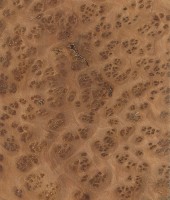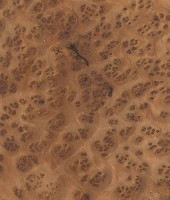 |
Common Name(s): Thuya (burl) Scientific Name: Tetraclinis articulata Distribution: Atlas mountain region (primarily Morocco, as well as subpopulations in Malta and southern Spain) Tree Size: 20-50 ft (6-15 m) tall, 1-2 ft (.3-.6 m) trunk diameter Average Dried Weight: 42 lbs/ft3 (680 kg/m3) Specific Gravity (Basic, 12% MC): .56, .68 Janka Hardness: 1,160 lbf (5,140 N) Modulus of Rupture: 13,600 lbf/in2 (93.8 MPa)* Elastic Modulus: 1,800,000 lbf/in2 (12.41 GPa)* Crushing Strength: 7,750 lbf/in2 (53.4 MPa)* *estimated values based on strength group found in African Timbers; for unfigured wood Shrinkage: Radial: 4.5%, Tangential: 5.1%, **shrinkage values are for burl wood |
Color/Appearance: Color is generally an orangish or reddish brown. Color tends to darken with age to a medium to dark reddish brown. Nearly always exported and sold as burls from the root of the tree, with plain or unfigured wood of little commercial value.
Grain/Texture: Burl blocks can vary in frequency and size of knot clusters, but grain is more or less swirled/irregular. With a medium to fine texture and good natural luster.
Endgrain: No data available.
Rot Resistance: Rated as durable; good insect/borer resistance.
Workability: Like most other burls, Thuya burl can be difficult to work, and care must be taken to avoid tearout. Most shaping/planing operations will result in torn grain, and should be performed by hand with very sharp tools. Sands and finishes well.
Odor: Thuya has a very distinct, cedar-like smell.
Allergies/Toxicity: Although severe reactions are quite uncommon, Thuya has been reported to cause eye and skin irritation. See the articles Wood Allergies and Toxicity and Wood Dust Safety for more information.
Pricing/Availability: Most commonly sold as root burls. Expect prices to be very high, particularly on pieces with premium figuring exhibiting numerous tightly-packed burl eyes.
Sustainability: This wood species is not listed in the CITES Appendices, and is reported by the IUCN as being a species of least concern. However, the small subpopulations in Malta and Spain are both regionally endangered.
Common Uses: Carvings, veneer, decorative boxes, turned objects, and other small speciality wood items.
Comments: Cedar-like tree that is the sole species in the Tetraclinis genus, though the tree has been formerly classified in the Thuja genus, and the scent is very similar to Western Red Cedar (Thuja occidentalis). National tree of Malta. Sometimes called Thyine or Citron wood.
None available.
None available.
 |
 |





I have a thuya box that cost a fortune and I’m going to buy another. They’re stunning.
Beautiful wood, but wow does it clog sandpaper! It feels oily/waxy, so much so that when I made a box, I made sure to first wipe down the mitered edges with acetone before I glued up with Titebond III. Takes a Sam Maloof-type finish very well. Spendy, too. A block 3″ x 3″ x 8″ cost me $50 at my local exotic woods store.
I’ve worked with this wood for several years now and the smell reminded of something from my childhood, bit I never could quite place what it was.
One night I had a dream that I was a child again and emptying the pencil sharpener in the classroom. Bingo ! That’s what Thuya reminds me of – pencil shavings.
I came back from Morrocco having bought 18kg of Thuya burr for about £60, one peice was 260 x 260 x 116mm and the rest smaller. Makes beautifil clock surrounds. Am just turning a salad bow, having cored the lump into two. HOWEVER I find the wood dust gives me all the sympomes of a cold with eye irritaton & sneezing, it has a sweet and strong smell. Warning, use good extraction plus a helmet that extract the dust. Its a beautiful wood and polishes to a high shine.
From what I’ve read, the burl is only found in the root system of this particular tree. As such, there are no pieces larger than a foot or so available. My sister and husband just came back from Morocco with a piece just big enough for me to make a small knife handle. Beautiful stuff!
I am making a sculpture. The idea is to make 2 Fender Stratocastors (They is the classic electric guitar
you see everywhere the last 50 years ) out of an exotic would I would Like to get it made in Morrocco..
IS THIS A GOOD IDEA ? IS IT SUITABLE? WILL IT KEEP IT’S SHAPE AND NOT WARP.
PLEASE HELP ME .
Hi Steve,
I’ve used various exotics to make guitars, this is probably better used as a frontal veneer for your Strats and use a a more stable wood for the carcase of the guitar. Same goes for the Fret board, ok for the fret board itself, but use maple or similar for the main part of the neck.